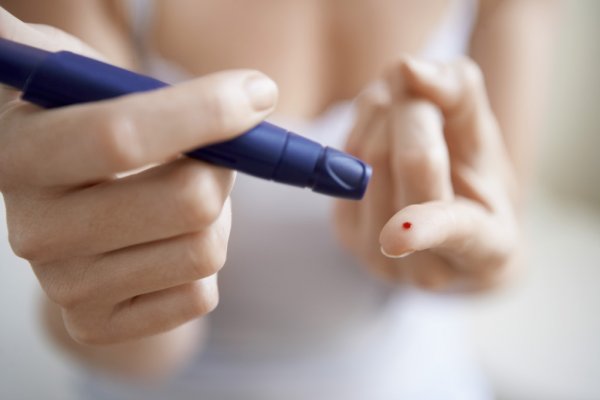Diabetes is a common metabolic disease, provoking high blood sugar. The main role in diabetes plays the hormone insulin that helps to store the sugar in the cells and use it as an energy source.
When you have diabetes, the body doesn’t produce the needed insulin or doesn’t use the produced one. If untreated, diabetes can cause eyes and kidney failure and severe nerve damage.
There are various types of diabetes, including:
Type 1 diabetes is what 10% of people have, and it’s an autoimmune disease. The body itself destroys the pancreas cells, an organ where insulin is produced.
Type 2 diabetes is the one where sugar levels in the blood become too high as the body becomes insulin resistant.
Prediabetes is high blood sugar, but not high enough to be called Type 2 diabetes.
Gestational diabetes is high blood sugar only appearing in pregnant women. It’s caused by insulin-stopping hormones in the placenta.

Symptoms of Diabetes
General Symptoms
- Weight loss
- Increased hunger
- Blurry vision
- Never healing sores
- Abnormal thirst
In men, the symptoms can also include erectile dysfunction and lack of sexual appetite while women with diabetes can experience dry skin, frequent urinary tract infections, and yeast infections.
Type 1 diabetes symptoms
- Blurry vision
- Extreme hunger and thirst
- Extreme weight loss
- Tiredness
- Frequent urination
Type 2 diabetes symptoms
- Blurry vision
- Increased hunger and thirst
- Tiredness
- Slow-healing sores
- Tiredness
- Frequent infections due to high glucose levels that don’t let the body heal.
Gestational Diabetes symptoms
This type of diabetes actually doesn’t have any symptoms, and it’s discovered only when pregnant women undergo a blood sugar test.
What Causes Diabetes?
Type 1 diabetes
Unfortunately, doctors don’t know what causes this type, and for some unknown reason, the immune system destroys the pancreas cells. In most cases, it’s genetic.
Type 2 diabetes
This type is caused by a mix of genetic and dietary factors. It’s mostly common in obese or overweight people, especially the ones with excess belly fat, and it mostly runs in families.
Gestational diabetes
There is only one cause for gestational diabetes, and that’s hormonal changes during pregnancy.
What Are the Risk Factors?
Type 1 diabetes
People prone to this type are teenagers and the ones who carry it into their genes.
Type 2 diabetes
The risk factors for Type 2 diabetes are more numerous, therefore, this type is more common. You are at risk to get sick if you are: overweight, over 45 years old, carry it in your genes, physically inactive, have prediabetes, have high cholesterol, high triglycerides, or high blood pressure.
Gestational diabetes
The main risk factors that can lead to this diabetes type are if you are overweight, over 25 years old, if you suffered the disease in your previous pregnancy, if you have polycystic ovarian syndrome, or if there’s Type 2 diabetes in your family.
Diabetes Complications
The first thing to know is that high blood sugar levels can damage many of your organs or compromise their functions. If you suffer this disease for a long time without treating it, then you are most likely to face the following complications:
- Stroke, heart attack, cardiovascular diseases
- Neuropathy
- Vision loss
- Nephropathy
- Foot sores that don’t heal
- Bacterial and fungal infection on the skin
- Dementia
- Hearing loss
- Severe depression
Gestational diabetes can lead to premature birth or excessive weight at birth. Also, it can cause low blood sugar levels, and in some cases, Type 2 diabetes appears years after giving birth.
Treatment of Diabetes
Diabetes can be treated with different medications, but the most common and most effective treatment is insulin injection.
Type 1 Diabetes is treated with insulin injections because they replace the hormone that the body can’t produce. There are four types of insulin injections that you need to know about:
Rapid-acting insulin has a 3-4-hour effect, it starts working within 15 minutes.
Short-acting insulin has a 4-8-hour effect, it starts working within 30 minutes.
Intermediate-acting insulin has a 12-18-hour effect, it starts working within 2 hours.
Long-acting insulin has a 24 hours or more effect, but it starts working a couple of hours after injecting.
Treatment of diabetes when it comes to Type 2 is more based on pills, depending on your doctor. For example,
- Metformin is a medicine that decreases glucose produced by the liver, while
- Dulaglutide changes the way insulin is produced by your body.
- Acarbose is a medicine that slows the digestion of sugars in the body,
- Nateglinide and Prandin stimulate the production of insulin, and Pioglitazone boosts insulin’s work.
However, if diagnosed with Type 2 diabetes, try losing weight, changing your diet, and exercise as this type depends on your lifestyle.
Gestational diabetes is treated with insulin in only 10-20% of the cases and doesn’t affect the development of the baby.

How Can You Prevent Diabetes?
Well, if you carry it in your genes, you can’t prevent Type 1 diabetes. As for Type 2, unless it’s genetic or coming with your age, you can surely prevent it by making some dietary changes.
Cutting off saturated fats and carbs from your diet, and adding vegetables and whole-grain foods can balance your body and prevent many illnesses including diabetes.
Walking, jogging, cycling, or doing some cardio at home, and losing weight can also keep your body away from the disease.
Diabetes in Children
Diabetes in children is becoming one of the biggest problems of our time, and mostly because of obesity.
Controlling diabetes in young children is extremely important and it requires frequent testing and a balanced diet.
Type 1 diabetes in kids can’t be stopped as it is an autoimmune disease, but it can be recognized on time. If your kid is wetting the bed after learning how to use a toilet, and it’s drinking too many liquids, then it’s time for a doctor visit.
Type 2 diabetes is most common in kids in the last decades, especially in the US, where kids’ obesity is 18,5%. Over 40% of children with Type 2 diabetes don’t show any symptoms, which is extremely dangerous because it can lead to heart, eyes, and kidney failure.
Final Word
Type 1 diabetes is out of your control, as it is an autoimmune disease. Type 2 diabetes can be prevented with healthy food, physical activity, and weight loss. However, blood sugar testing should be part of your routine medical checkups.



